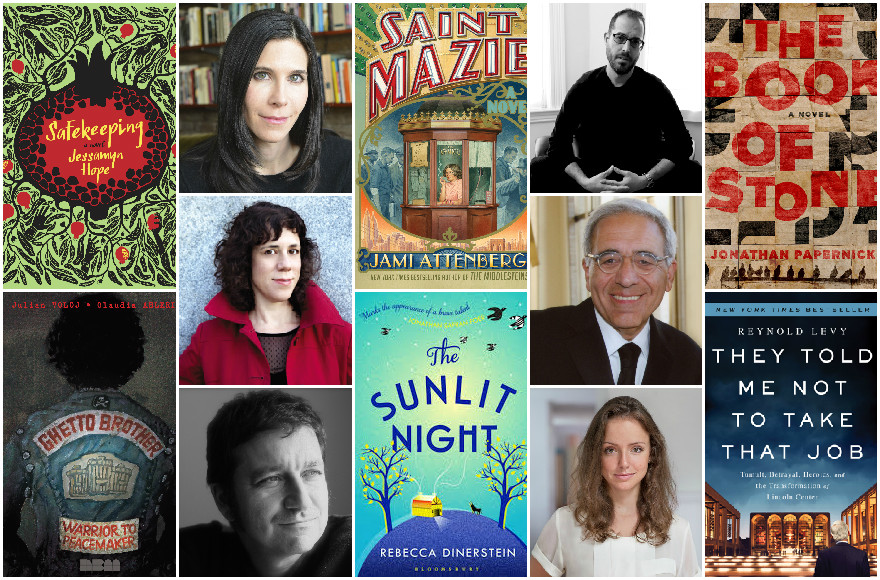Summertime, and the readin’ is easy
Published June 25, 2015

Author headshots, clockwise from top left Jessmyn Hope, Jonathan Papernick, Reynold Levy, Rebecca Dinerstein (Nina Subin), Julian Voloj and Jami Attenberg (Michael Sharkey). Courtesy of the publisher unless otherwise noted.
It’s summer, that time of year when everyone drops everything they’re doing, finds a quiet stretch of sandy shore and spends all day delving into their new favorite books. Or maybe not. But whatever your plans, there’s no denying that the season brings a bumper crop of literary offerings, plus an abundance of lists telling you which ones you “must read.” So here’s ours, a sterling selection of new books whose authors and/or themes provide some fun Jewish flair — just right for a beach read or an everyday coffee-break escape.
“Book of Numbers” (Random House)
By Joshua CohenThe prolific, 34-year-old Joshua Cohen presents his fourth novel in less than a decade, with a protagonist who is also a Jewish novelist named Joshua Cohen — only this nebbish is hardly prolific. With mounting debts, he agrees to ghostwrite the memoir of the eccentric, billionaire founder of a Google-like tech firm (who is, as it happens, also named Joshua Cohen). What follows is part thriller, part family drama and part sex comedy — but primarily it’s a pointed deliberation on what it means to live in the age of search engines, smartphones and constant surveillance.
“The Book of Stone” (Fig Tree Books)
By Jonathan Papernick
In the grey gap between good and evil, there’s almost always a great story. After his successful collections of short fiction, author Papernick has gone longform with this psychological thriller that explores the evolution of the terrorist mindset and the complexities of religious radicalism (and, yes, that’s radicalism of the Jewish kind). This may not be an uplifting tale of faith reconsidered — “The Book of Stone” ain’t Broadway’s “The Book of Mormon” — but it’s an engrossing read about a sorrowful soul whose search for meaning leads to a very dark mission.
“Compulsion” (Fig Tree Books)
By Meyer Levin
When truth is more sensational than fiction, just fictionalize the truth — which is precisely what Levin did in “Compulsion,” the classic 1956 novel that reimagines, ever so slightly, the famous kidnap-murder case of Leopold and Loeb. Levin was the killers’ classmate at the University of Chicago and covered their 1924 trial for the Chicago Daily News. And though he changed names and details, his book (and the play and movie that followed) is generally recognized as paving the way for non-fiction novels such as Truman Capote’s “In Cold Blood.” Nearly a century after this “crime of the century,” Levin’s tale — in this new edition, with a foreword by O.J. prosecutor-turned-novelist Marcia Clark — is no less gripping or disturbing.
“Ghetto Brother: Warrior to Peacemaker” (NBM Publishing)
By Julian Voloj, with art by Claudia Ahlering
Here’s a fascinating, largely unknown story that’s told in a compelling, unexpected way. Set at the height of gang warfare in the South Bronx in 1971, this graphic novel depicts — through Voloj’s lively writing and Ahlering’s funky illustrations — the true story of Benjy Melendez. The son of Puerto Rican immigrants, Melendez founded the notorious Ghetto Brothers gang but eventually initiated a truce that spread across the borough and beyond. More than that, the Ghetto Brothers, also a band, held weekly concerts — and this cross-pollination of creativity ultimately laid the foundation of hip-hop culture. Melendez eventually “retired” from gang life, focusing on reclaiming his roots after learning of his — wait for it — hidden Jewish background.
“Safekeeping” (Fig Tree Books)
By Jessamyn Hope
In 1994, an Israeli kibbutz filled with colorful, seemingly incompatible characters welcomes Adam, a drug-addicted New Yorker on a mission to right a past wrong: he must return a medieval sapphire brooch to his grandfather’s old flame, if only he can track her down. Hope’s debut novel draws on her own experiences living as an outsider on a kibbutz in the mid 1990s, but also delves back into turbulent moments in Jewish history. Spanning seven centuries and three continents, it’s one of those sweeping epics that’s easy to get swept up in.
“Saint Mazie” (Grand Central Publishing)
By Jami Attenberg
With her fourth novel, Attenberg once again deploys the wit and sympathy that made 2012’s “The Middlesteins” such a big-hearted hit. Inspired by the life of a real Depression-era Jewish “saint,” the star of this Jazz Age tale is the bawdy and blunt ticket-taker at a popular Lower East Side movie theater who becomes a heroine to the homeless after the stock market crash. Mazie is a joy to meet and a marvel to behold, as her story emerges through a series of diary entries and snippets of interviews with people who knew her.
This entry passed through the Full-Text RSS service – if this is your content and you’re reading it on someone else’s site, please read the FAQ at fivefilters.org/content-only/faq.php#publishers.














